Jiangpeng He
Evaluating Large Multimodal Models for Nutrition Analysis: A Benchmark Enriched with Contextual Metadata
Jul 09, 2025Abstract:Large Multimodal Models (LMMs) are increasingly applied to meal images for nutrition analysis. However, existing work primarily evaluates proprietary models, such as GPT-4. This leaves the broad range of LLMs underexplored. Additionally, the influence of integrating contextual metadata and its interaction with various reasoning modifiers remains largely uncharted. This work investigates how interpreting contextual metadata derived from GPS coordinates (converted to location/venue type), timestamps (transformed into meal/day type), and the food items present can enhance LMM performance in estimating key nutritional values. These values include calories, macronutrients (protein, carbohydrates, fat), and portion sizes. We also introduce ACETADA, a new food-image dataset slated for public release. This open dataset provides nutrition information verified by the dietitian and serves as the foundation for our analysis. Our evaluation across eight LMMs (four open-weight and four closed-weight) first establishes the benefit of contextual metadata integration over straightforward prompting with images alone. We then demonstrate how this incorporation of contextual information enhances the efficacy of reasoning modifiers, such as Chain-of-Thought, Multimodal Chain-of-Thought, Scale Hint, Few-Shot, and Expert Persona. Empirical results show that integrating metadata intelligently, when applied through straightforward prompting strategies, can significantly reduce the Mean Absolute Error (MAE) and Mean Absolute Percentage Error (MAPE) in predicted nutritional values. This work highlights the potential of context-aware LMMs for improved nutrition analysis.
CL-LoRA: Continual Low-Rank Adaptation for Rehearsal-Free Class-Incremental Learning
May 30, 2025Abstract:Class-Incremental Learning (CIL) aims to learn new classes sequentially while retaining the knowledge of previously learned classes. Recently, pre-trained models (PTMs) combined with parameter-efficient fine-tuning (PEFT) have shown remarkable performance in rehearsal-free CIL without requiring exemplars from previous tasks. However, existing adapter-based methods, which incorporate lightweight learnable modules into PTMs for CIL, create new adapters for each new task, leading to both parameter redundancy and failure to leverage shared knowledge across tasks. In this work, we propose ContinuaL Low-Rank Adaptation (CL-LoRA), which introduces a novel dual-adapter architecture combining \textbf{task-shared adapters} to learn cross-task knowledge and \textbf{task-specific adapters} to capture unique features of each new task. Specifically, the shared adapters utilize random orthogonal matrices and leverage knowledge distillation with gradient reassignment to preserve essential shared knowledge. In addition, we introduce learnable block-wise weights for task-specific adapters, which mitigate inter-task interference while maintaining the model's plasticity. We demonstrate CL-LoRA consistently achieves promising performance under multiple benchmarks with reduced training and inference computation, establishing a more efficient and scalable paradigm for continual learning with pre-trained models.
Robust3D-CIL: Robust Class-Incremental Learning for 3D Perception
Mar 18, 2025Abstract:3D perception plays a crucial role in real-world applications such as autonomous driving, robotics, and AR/VR. In practical scenarios, 3D perception models must continuously adapt to new data and emerging object categories, but retraining from scratch incurs prohibitive costs. Therefore, adopting class-incremental learning (CIL) becomes particularly essential. However, real-world 3D point cloud data often include corrupted samples, which poses significant challenges for existing CIL methods and leads to more severe forgetting on corrupted data. To address these challenges, we consider the scenario in which a CIL model can be updated using point clouds with unknown corruption to better simulate real-world conditions. Inspired by Farthest Point Sampling, we propose a novel exemplar selection strategy that effectively preserves intra-class diversity when selecting replay exemplars, mitigating forgetting induced by data corruption. Furthermore, we introduce a point cloud downsampling-based replay method to utilize the limited replay buffer memory more efficiently, thereby further enhancing the model's continual learning ability. Extensive experiments demonstrate that our method improves the performance of replay-based CIL baselines by 2% to 11%, proving its effectiveness and promising potential for real-world 3D applications.
Online Prototypes and Class-Wise Hypergradients for Online Continual Learning with Pre-Trained Models
Feb 26, 2025Abstract:Continual Learning (CL) addresses the problem of learning from a data sequence where the distribution changes over time. Recently, efficient solutions leveraging Pre-Trained Models (PTM) have been widely explored in the offline CL (offCL) scenario, where the data corresponding to each incremental task is known beforehand and can be seen multiple times. However, such solutions often rely on 1) prior knowledge regarding task changes and 2) hyper-parameter search, particularly regarding the learning rate. Both assumptions remain unavailable in online CL (onCL) scenarios, where incoming data distribution is unknown and the model can observe each datum only once. Therefore, existing offCL strategies fall largely behind performance-wise in onCL, with some proving difficult or impossible to adapt to the online scenario. In this paper, we tackle both problems by leveraging Online Prototypes (OP) and Class-Wise Hypergradients (CWH). OP leverages stable output representations of PTM by updating its value on the fly to act as replay samples without requiring task boundaries or storing past data. CWH learns class-dependent gradient coefficients during training to improve over sub-optimal learning rates. We show through experiments that both introduced strategies allow for a consistent gain in accuracy when integrated with existing approaches. We will make the code fully available upon acceptance.
MFP3D: Monocular Food Portion Estimation Leveraging 3D Point Clouds
Nov 14, 2024
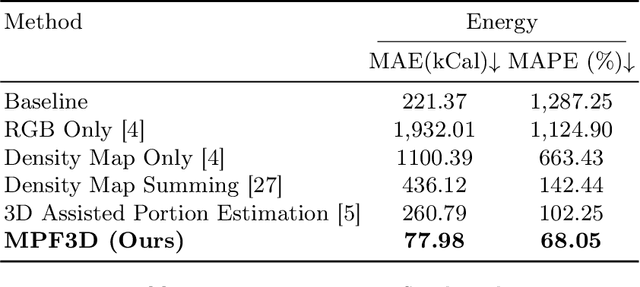
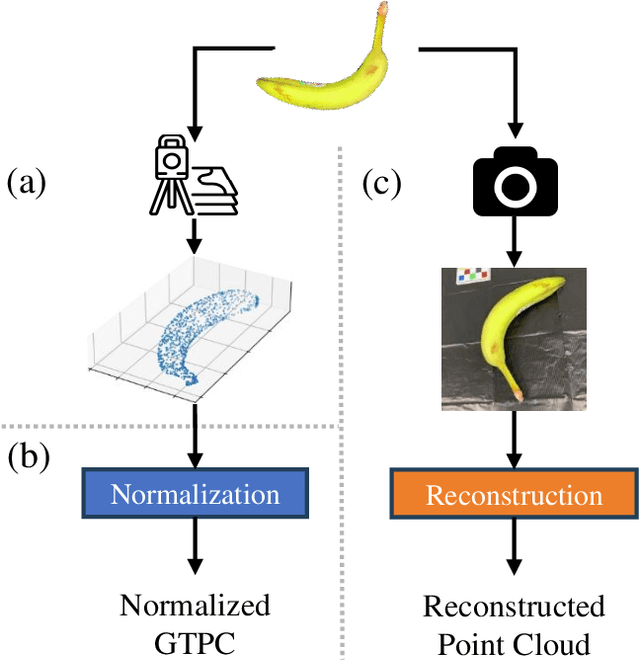
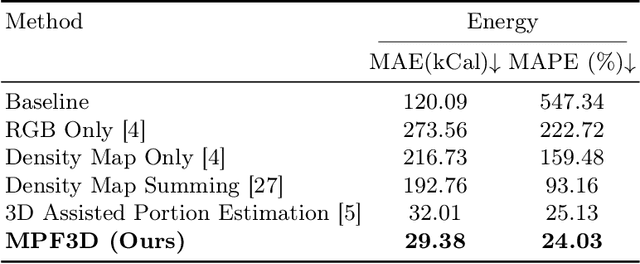
Abstract:Food portion estimation is crucial for monitoring health and tracking dietary intake. Image-based dietary assessment, which involves analyzing eating occasion images using computer vision techniques, is increasingly replacing traditional methods such as 24-hour recalls. However, accurately estimating the nutritional content from images remains challenging due to the loss of 3D information when projecting to the 2D image plane. Existing portion estimation methods are challenging to deploy in real-world scenarios due to their reliance on specific requirements, such as physical reference objects, high-quality depth information, or multi-view images and videos. In this paper, we introduce MFP3D, a new framework for accurate food portion estimation using only a single monocular image. Specifically, MFP3D consists of three key modules: (1) a 3D Reconstruction Module that generates a 3D point cloud representation of the food from the 2D image, (2) a Feature Extraction Module that extracts and concatenates features from both the 3D point cloud and the 2D RGB image, and (3) a Portion Regression Module that employs a deep regression model to estimate the food's volume and energy content based on the extracted features. Our MFP3D is evaluated on MetaFood3D dataset, demonstrating its significant improvement in accurate portion estimation over existing methods.
MetaFood3D: Large 3D Food Object Dataset with Nutrition Values
Sep 03, 2024Abstract:Food computing is both important and challenging in computer vision (CV). It significantly contributes to the development of CV algorithms due to its frequent presence in datasets across various applications, ranging from classification and instance segmentation to 3D reconstruction. The polymorphic shapes and textures of food, coupled with high variation in forms and vast multimodal information, including language descriptions and nutritional data, make food computing a complex and demanding task for modern CV algorithms. 3D food modeling is a new frontier for addressing food-related problems, due to its inherent capability to deal with random camera views and its straightforward representation for calculating food portion size. However, the primary hurdle in the development of algorithms for food object analysis is the lack of nutrition values in existing 3D datasets. Moreover, in the broader field of 3D research, there is a critical need for domain-specific test datasets. To bridge the gap between general 3D vision and food computing research, we propose MetaFood3D. This dataset consists of 637 meticulously labeled 3D food objects across 108 categories, featuring detailed nutrition information, weight, and food codes linked to a comprehensive nutrition database. The dataset emphasizes intra-class diversity and includes rich modalities such as textured mesh files, RGB-D videos, and segmentation masks. Experimental results demonstrate our dataset's significant potential for improving algorithm performance, highlight the challenging gap between video captures and 3D scanned data, and show the strength of the MetaFood3D dataset in high-quality data generation, simulation, and augmentation.
FMiFood: Multi-modal Contrastive Learning for Food Image Classification
Aug 07, 2024Abstract:Food image classification is the fundamental step in image-based dietary assessment, which aims to estimate participants' nutrient intake from eating occasion images. A common challenge of food images is the intra-class diversity and inter-class similarity, which can significantly hinder classification performance. To address this issue, we introduce a novel multi-modal contrastive learning framework called FMiFood, which learns more discriminative features by integrating additional contextual information, such as food category text descriptions, to enhance classification accuracy. Specifically, we propose a flexible matching technique that improves the similarity matching between text and image embeddings to focus on multiple key information. Furthermore, we incorporate the classification objectives into the framework and explore the use of GPT-4 to enrich the text descriptions and provide more detailed context. Our method demonstrates improved performance on both the UPMC-101 and VFN datasets compared to existing methods.
MetaFood CVPR 2024 Challenge on Physically Informed 3D Food Reconstruction: Methods and Results
Jul 12, 2024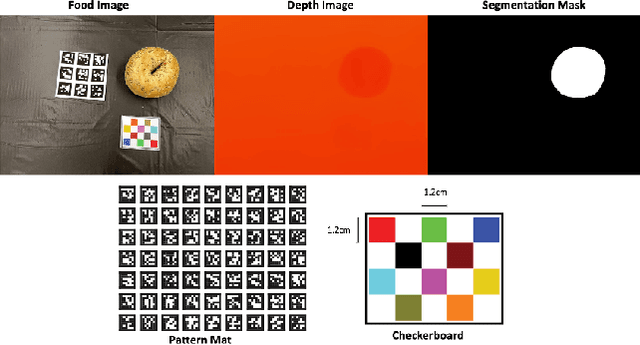
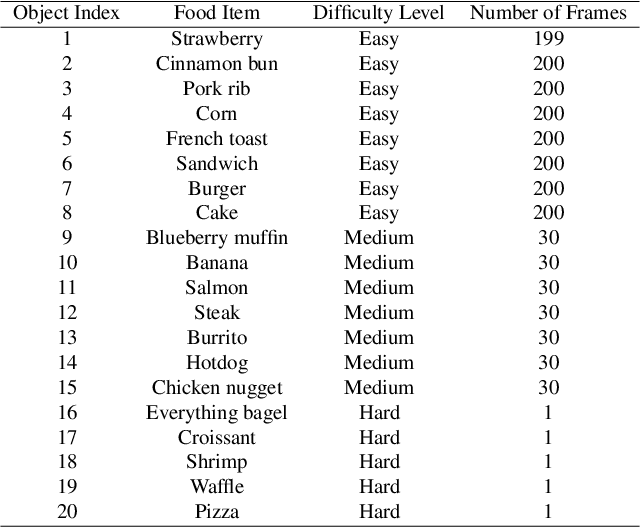
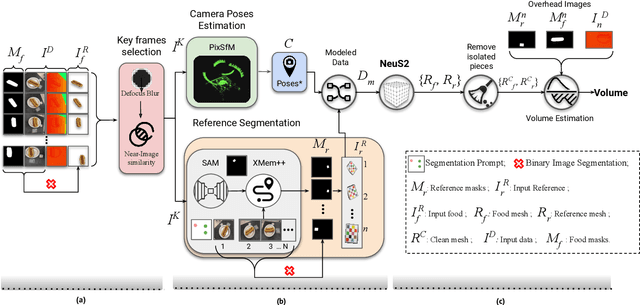
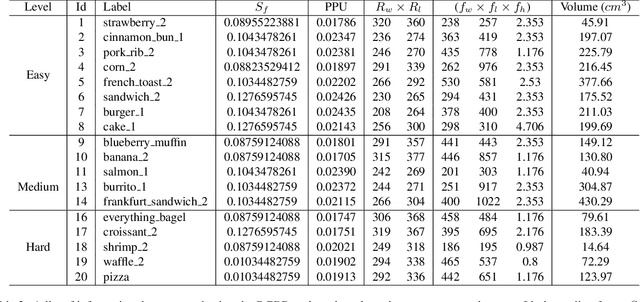
Abstract:The increasing interest in computer vision applications for nutrition and dietary monitoring has led to the development of advanced 3D reconstruction techniques for food items. However, the scarcity of high-quality data and limited collaboration between industry and academia have constrained progress in this field. Building on recent advancements in 3D reconstruction, we host the MetaFood Workshop and its challenge for Physically Informed 3D Food Reconstruction. This challenge focuses on reconstructing volume-accurate 3D models of food items from 2D images, using a visible checkerboard as a size reference. Participants were tasked with reconstructing 3D models for 20 selected food items of varying difficulty levels: easy, medium, and hard. The easy level provides 200 images, the medium level provides 30 images, and the hard level provides only 1 image for reconstruction. In total, 16 teams submitted results in the final testing phase. The solutions developed in this challenge achieved promising results in 3D food reconstruction, with significant potential for improving portion estimation for dietary assessment and nutritional monitoring. More details about this workshop challenge and access to the dataset can be found at https://sites.google.com/view/cvpr-metafood-2024.
Automatic Recognition of Food Ingestion Environment from the AIM-2 Wearable Sensor
May 13, 2024


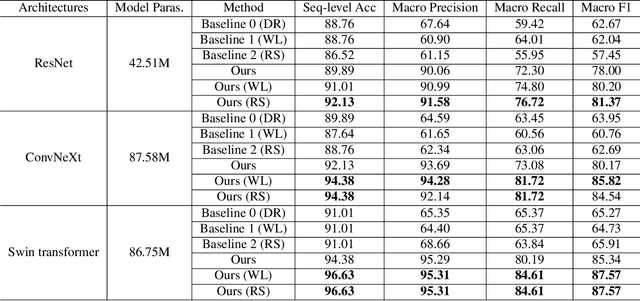
Abstract:Detecting an ingestion environment is an important aspect of monitoring dietary intake. It provides insightful information for dietary assessment. However, it is a challenging problem where human-based reviewing can be tedious, and algorithm-based review suffers from data imbalance and perceptual aliasing problems. To address these issues, we propose a neural network-based method with a two-stage training framework that tactfully combines fine-tuning and transfer learning techniques. Our method is evaluated on a newly collected dataset called ``UA Free Living Study", which uses an egocentric wearable camera, AIM-2 sensor, to simulate food consumption in free-living conditions. The proposed training framework is applied to common neural network backbones, combined with approaches in the general imbalanced classification field. Experimental results on the collected dataset show that our proposed method for automatic ingestion environment recognition successfully addresses the challenging data imbalance problem in the dataset and achieves a promising overall classification accuracy of 96.63%.
Food Portion Estimation via 3D Object Scaling
Apr 18, 2024



Abstract:Image-based methods to analyze food images have alleviated the user burden and biases associated with traditional methods. However, accurate portion estimation remains a major challenge due to the loss of 3D information in the 2D representation of foods captured by smartphone cameras or wearable devices. In this paper, we propose a new framework to estimate both food volume and energy from 2D images by leveraging the power of 3D food models and physical reference in the eating scene. Our method estimates the pose of the camera and the food object in the input image and recreates the eating occasion by rendering an image of a 3D model of the food with the estimated poses. We also introduce a new dataset, SimpleFood45, which contains 2D images of 45 food items and associated annotations including food volume, weight, and energy. Our method achieves an average error of 31.10 kCal (17.67%) on this dataset, outperforming existing portion estimation methods.
 Add to Chrome
Add to Chrome Add to Firefox
Add to Firefox Add to Edge
Add to Edge